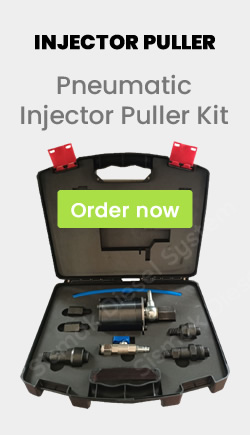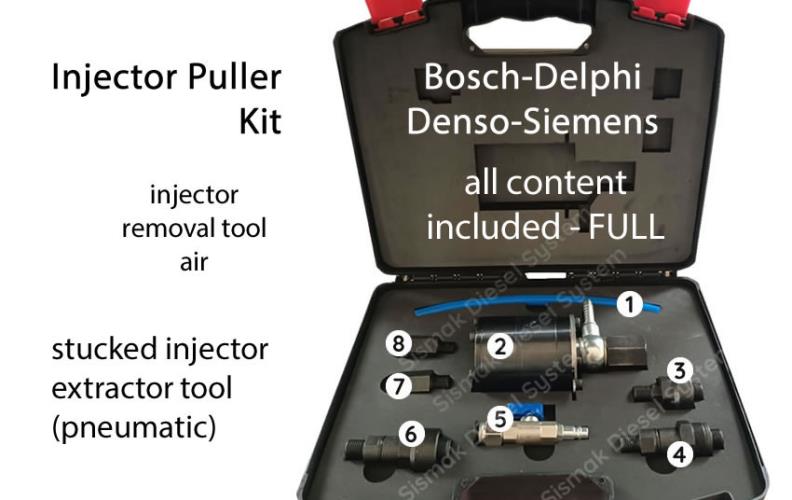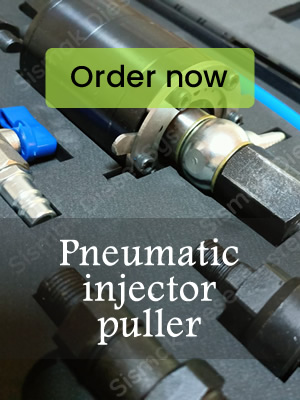
Stucked injector extractor tool
Pneumatic Injector Puller Extractor
stucked Injector Extractor Tool (Pneumatic),
Diesel Injector Extractor with Air  content viewed 6136 times
content viewed 6136 times

- pneumatic injector puller kit (air-operated injector puller)
- stucked Injector Extractor Tool (Pneumatic)
- stucked injector extractor tool
- Injector Extractor Tool
- Pneumatic Injector Puller Extractor
- Diesel Injector Extractor with Air
Why is the diesel injector stuck?
There could be several reasons why a diesel injector may be stuck. Here are a few possibilities:
- Contaminated Fuel: Diesel fuel can sometimes contain impurities or contaminants that can clog the injector nozzle or cause it to stick. This can happen if the fuel filters are not regularly replaced or if there is a problem with the fuel supply.
- Carbon Deposits: Over time, carbon deposits can build up on the injector nozzle, preventing it from operating properly. This can occur due to incomplete combustion or the use of low-quality fuel. The carbon deposits can restrict the flow of fuel or cause the injector needle to stick.
- Mechanical Failure: Diesel injectors are precision-engineered components that rely on precise tolerances to function correctly. If there is a mechanical failure, such as a worn-out or damaged injector needle or spring, it can lead to the injector getting stuck.
- Electrical Issues: Modern diesel injectors are often electronically controlled, and they rely on signals from the engine control unit (ECU) to operate. If there is a problem with the electrical circuit or the ECU itself, it can cause the injector to malfunction and become stuck.
- Injector Solenoid Failure: The injector solenoid is responsible for opening and closing the injector nozzle. If the solenoid fails, it can cause the injector to remain stuck in either the open or closed position.
To diagnose and resolve the issue, it is recommended to take your vehicle to a qualified mechanic or a diesel specialist. They will be able to inspect the injectors, identify the underlying cause, and perform the necessary repairs or maintenance procedures.
If a diesel injector gets stuck in a vehicle, it can have several consequences, depending on the specific circumstances and the extent of the problem. Here are a few potential outcomes:

1. Engine Misfire: A stuck injector can disrupt the proper fuel delivery to the engine cylinder. This can result in an engine misfire, where the affected cylinder fails to ignite the fuel-air mixture properly. Engine misfires can cause rough idling, reduced power, and poor fuel efficiency.
2. Engine Performance Issues: A stuck injector can lead to uneven fuel distribution among the cylinders, resulting in imbalanced engine performance. This can cause a loss of power, reduced acceleration, and overall decreased performance of the vehicle.
3. Excessive Smoke: If the injector is stuck open or leaking, it can cause excessive fuel to be injected into the cylinder. This can result in black smoke emissions from the exhaust. Additionally, unburned fuel may pass through the exhaust system, potentially causing damage to catalytic converters or diesel particulate filters.
4. Starting Problems: A stuck injector can affect the engine's ability to start properly. If the injector is stuck closed or partially closed, it may restrict the fuel flow to the engine, leading to difficulty in starting the vehicle or prolonged cranking time.
5. Fuel Contamination: In some cases, a stuck injector can cause fuel leakage into the cylinder or the engine oil. This can lead to fuel dilution in the oil, reducing its lubrication properties and potentially causing damage to engine components.
It's important to address a stuck injector promptly to avoid further damage to the engine or other components. If you suspect a stuck injector in your vehicle, it is advisable to have it inspected and repaired by a qualified mechanic or a diesel specialist. They can diagnose the issue accurately and carry out the necessary repairs to restore proper injector function.
How to remove a stuck injector?
Removing a stuck injector can be a challenging task, as it requires careful handling to avoid causing further damage. Here is a general procedure that can be followed to remove a stuck injector:
1. Preparation: Ensure that you have the necessary tools and safety equipment before starting the procedure. This may include a wrench or socket set, penetrating oil, gloves, safety glasses, and a fire extinguisher (as a precaution).
2. Disconnect the Battery: Before working on the injectors, disconnect the vehicle's battery to prevent any electrical mishaps or accidental engine starts.
3. Access the Injectors: Depending on the vehicle, you may need to remove any engine covers or components that obstruct access to the injectors. This could include air intake piping, fuel lines, or other components that need to be disconnected or moved out of the way.
4. Release Fuel Pressure: Relieve the fuel system pressure by locating the fuel pressure release valve or by disconnecting the fuel pump relay or fuse. This step is crucial to prevent fuel spray or leakage during the injector removal process.
5. Remove Fuel Lines: Disconnect the fuel lines from the injector rail and the fuel injector itself. Carefully detach any retaining clips or fasteners holding the lines in place, being cautious not to damage them in the process. Plug the open ends of the fuel lines to prevent debris or dirt from entering.
6. Remove Electrical Connections: Disconnect the electrical connectors from the injector. These connectors may have retaining clips or locks that need to be released before disconnecting. Take care not to damage the connectors or wiring.
7. Loosen Injector Retaining Bolts: Locate the bolts securing the injector to the fuel rail or the intake manifold. Loosen them gradually and evenly, using the appropriate wrench or socket size. Be careful not to overtighten or strip the bolts.
8. Apply Penetrating Oil: If the injector is stuck, applying a penetrating oil around the injector base can help loosen any rust or debris that may be causing it to stick. Allow the penetrating oil to work for a few minutes to help with the removal process.
9. Gently Remove the Injector: Once the injector bolts are sufficiently loosened and the penetrating oil has had time to work, gently pull the injector straight out of the fuel rail or intake manifold. Use steady and even pressure, avoiding any excessive force or twisting motion that could damage the injector or its housing.
10. Clean and Inspect: After removing the injector, inspect it for any signs of damage or contamination. Clean the injector and its sealing surfaces thoroughly before reinstalling or replacing it. It's also a good idea to clean the injector port or seating area in the fuel rail or intake manifold.
It's important to note that the specific steps and procedures may vary depending on the make and model of your vehicle. It's always recommended to consult the vehicle's service manual or seek assistance from a qualified mechanic or technician with experience in injector removal if you are uncertain or unfamiliar with the process.
- pneumatic injector puller kit (air-operated injector puller)
- stucked Injector Extractor Tool (Pneumatic)
- stucked injector extractor tool
- Injector Extractor Tool
- Pneumatic Injector Puller Extractor
- Diesel Injector Extractor with Air
Use air-operated injector puller

An air-operated injector puller is a specialized tool designed to remove stuck or stubborn fuel injectors from an engine. Here's a general guideline on how to use an air-operated injector puller:
1. Prepare the Equipment: Ensure you have the necessary equipment and safety gear, including the air-operated injector puller, an air compressor, appropriate fittings, and protective goggles.
2. Access the Injector: Remove any components that may obstruct access to the injector, such as engine covers, air intake piping, or fuel lines. You may need to refer to the vehicle's service manual for specific instructions on accessing the injectors.
3. Prepare the Air Compressor: Connect the air compressor to a suitable air supply and ensure it is properly pressurized. Check that the air pressure is within the recommended range for the injector puller tool you are using.
4. Attach the Injector Puller: Attach the appropriate fitting or adapter to the air-operated injector puller tool. The specific type of fitting or adapter required will depend on the design of the tool and the injector you are working with. Follow the manufacturer's instructions for proper attachment.
5. Position the Puller Tool: Position the injector puller tool in a way that aligns with the injector you want to remove. The tool should engage with the injector securely to apply pulling force.
6. Apply Pressure: Activate the air-operated injector puller by turning on the air supply to the tool. This will generate the necessary force to pull the injector out of its seating.
7. Monitor the Pulling Process: As the tool applies pressure, keep an eye on the progress of the injector extraction. It's important to exercise caution and avoid applying excessive force that could damage the injector or other engine components. The tool should gradually and evenly pull the injector out of its housing.
8. Remove the Injector: Once the injector has been successfully pulled out, carefully detach it from the tool. Take note of any seals or O-rings that may be attached to the injector and ensure they are properly removed and replaced if necessary.
9. Inspect and Clean: Inspect the injector and its seating area for any signs of damage, contamination, or wear. Clean both the injector and the seating area thoroughly before reinstalling or replacing the injector.
Always follow the manufacturer's instructions for the specific air-operated injector puller tool you are using, as the steps and procedures may vary slightly. If you are unsure or inexperienced, it's recommended to seek assistance from a professional mechanic or technician who has experience with this type of tool to ensure safe and proper usage.
Added in Jun 2023 - Reviewed 6136 times